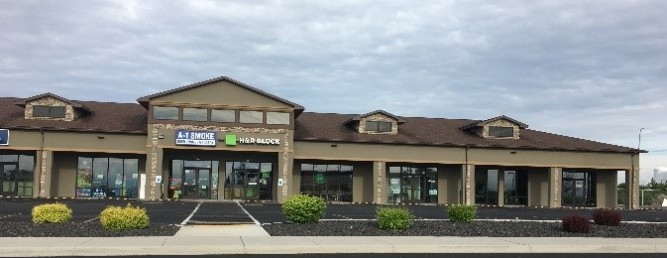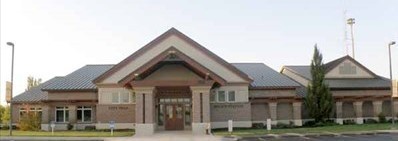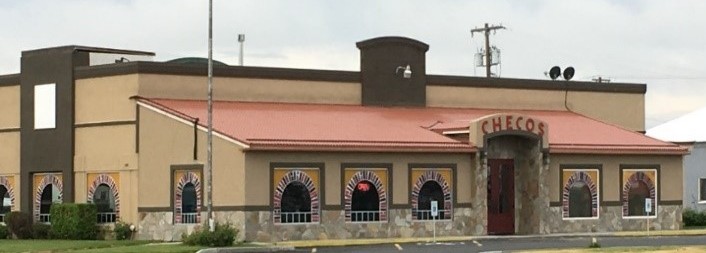Chapter 17.30
COMMERCIAL ZONES
Sections:
17.30.020 Additional requirements.
17.30.050 Development standards.
17.30.060 Performance standards.
17.30.070 Design standards in the C-1 and C-2 zones.
17.30.080 Design standards in the C-3 zone.
17.30.090 Construction code requirements.
17.30.110 Stormwater and drainage.
17.30.120 Pedestrian standards.
17.30.010 Purpose.
(a) Generally. This chapter provides for a well distributed system of retail and service uses with appropriate standards to create an attractive, economically thriving commercial base for the community.
(b) C-1 Traditional Commercial Zone. The C-1 zone retains the traditional downtown development pattern of buildings directly abutting the sidewalk with limited to no on-site parking. This is a compact area with traditional building styles.
(c) C-2 Central Commercial Zone. The C-2 zone caters to both pedestrian and vehicle traffic. On-site parking is required but customers may choose to park once and visit several businesses by walking. Design standards ensure buildings create a lively and attractive environment.
(d) C-3 Large-Scale Commercial Zone. The C-3 zone is intended for “big box” stores and other businesses that generally attract customers in vehicles. While walking between businesses is an option, it is less likely in this zone with its larger buildings and extensive parking lots. Buildings are pleasing to the eye but design standards are less stringent than in the other commercial zones. (Ord. 1547 § 4 (part), 2020).
17.30.020 Additional requirements.
Additional requirements are found in other chapters of the Municipal Code and other adopted city regulations, included but not limited to the following:
(a) Chapter 17.05, Interpretation, Purpose, Applicability;
(b) Chapter 17.56, General Provisions;
(c) Chapter 17.61, Off-Street Parking;
(d) Chapter 17.65, Building Permits;
(e) Chapter 17.74, Landscaping and Screening;
(f) Chapter 14.04, Building Codes;
(g) Chapter 14.58, Signs;
(h) Title 19, Development Code;
(i) City of Othello Public Works Design Standards. (Ord. 1547 § 4 (part), 2020).
17.30.030 Uses.
(a) The commercial land use table indicates where categories of land uses may be permitted and whether those uses are allowed outright or by conditional use permit. Only commercial zones are included in this table. Land uses not listed are prohibited unless allowed through the process specified in subsection (c) of this section. Further interpretation of these zones may be obtained as specified in Section 19.03.020. Land uses are also subject to the footnotes following the table.
(b) The symbols used in the table represent the following:
(1) A = Allowed, subject to applicable standards and any footnotes.
(2) C = Conditionally allowed through the conditional use permit process, subject to applicable standards and any footnotes.
(3) X = Prohibited use.
(c) Uses similar to those listed may be established as allowed or conditionally allowed through the interpretation process in Section 19.03.020(b). In determining whether a use should be permitted, the administrator shall refer to the purpose statement in Section 17.30.010 and the most recent version of the North American Industry Classification System (NAICS), as used by federal agencies in the classification of business establishments.
|
USE CATEGORIES |
C-1 |
C-2 |
C-3 |
|---|---|---|---|
|
Retail |
|||
|
Retail use (other than those listed below) |
A1 |
A |
A |
|
Contractor supply and sales, lumberyard |
X |
A |
A |
|
Daily outdoor merchandise display |
A |
A |
A |
|
Drive-thru for a permitted use |
A |
A |
A |
|
Eating and drinking places |
A |
A |
A |
|
Farm and landscaping equipment sales, supplies, and service |
X |
A |
A |
|
Fuel stations |
X |
A |
A |
|
Manufactured home sales |
X |
A |
A |
|
Marijuana sales |
X |
X |
X |
|
Open sales lots in conjunction with a principal use which must be in an enclosed adjoining building |
X |
X |
A |
|
Vehicle sales lots (can include RVs, boats, trailers, and campers) (can include light service), in compliance with the development standards in Section 17.61.060 |
X |
X |
A |
|
Warehouse sales |
X |
X |
A |
|
|
|
|
|
|
Wholesale |
|||
|
Wholesale use when not associated with a retail use |
X |
X |
A |
|
|
|
|
|
|
Services |
|||
|
Service uses (other than those listed below) |
A2 |
A |
A |
|
Adult entertainment and cabarets (in compliance with Chapter 4.28)3 |
X |
X |
A |
|
Banking and financial services |
A |
A |
A |
|
Clubs, lodges, assembly halls |
X |
A |
A |
|
Cultural, recreational, and entertainment uses |
X |
A |
A |
|
Daily care providers (child care, elder care) |
A |
A |
X |
|
Dance hall |
X |
X |
A |
|
Drive-thru for a permitted use |
A |
A |
A |
|
Family day care home in an existing residence |
A |
A |
A |
|
Health care providers |
A |
A |
A |
|
Hospitals |
X |
X |
A |
|
Lodging (hotels and motels subject to review under Chapter 17.67) |
X |
A |
A |
|
Kennels, animal boarding, pet care |
X |
X |
A |
|
Personal service shops |
A |
A |
A |
|
Professional offices |
A |
A |
A |
|
Recreational vehicle park (in compliance with Chapter 17.44) |
X |
X |
C |
|
Rental of vehicles, trailers, and machinery |
X |
X |
A |
|
Repair and maintenance, including vehicles, small engines, and appliances |
X |
X |
A |
|
Theater |
X |
A |
A |
|
Truck stops, sales, and light repairs |
X |
X |
A |
|
Veterinarian |
X |
X |
A |
|
|
|
|
|
|
Transportation, Communication, and Utilities |
|||
|
Passenger transportation facilities, public or private |
X |
X |
A |
|
Personal wireless telecommunications facilities (in compliance with Chapter 16.68) |
X |
A |
A |
|
Utility facilities (such as well house, electrical substation, etc.) |
A |
A |
A |
|
|
|
|
|
|
Industrial and Storage |
|||
|
Cargo containers used for storage4 |
X |
A |
A |
|
Light manufacturing when subordinate to a retail sales outlet and contained in a building |
A |
A |
A |
|
Outside storage in conjunction with a principal use which is in an enclosed adjoining building |
X |
X5 |
A |
|
Self-storage, mini-storage, RV storage |
X |
X |
A |
|
Storage, warehousing, and distribution, not associated with a retail business |
X |
X |
A |
|
Truck parking6 |
X |
X |
A |
|
Wrecking yard, salvage yard, junk yard |
X |
X |
X |
|
|
|
|
|
|
Public and Institutional |
|||
|
Churches |
X |
A |
A |
|
Libraries |
A |
A |
A |
|
Municipal and governmental facilities, shops, and yards |
X |
A |
A |
|
Outdoor recreational, entertainment, or amusement facilities |
X |
X |
A |
|
Park, playground, athletic field, other noncommercial recreation |
A |
A |
A |
|
Schools, public or private |
X |
A |
A |
|
|
|
|
|
|
Residential |
|||
|
Adult family home in an existing residence |
A |
A |
A |
|
Assisted living facility |
X |
A |
A |
|
Manufactured or mobile home park |
X |
X |
X |
|
Multifamily residential use not in conjunction with a commercial structure |
X |
A7 |
X |
|
Residential use in a basement or upper story8 |
A |
A |
A |
Notes for Table 1:
1 Limited to buildings under two thousand square feet.
2 Limited to buildings under two thousand square feet.
3 An adult entertainment business must be at least seven hundred feet from any park, school, preschool, youth club, bus stop, day care center, or another adult entertainment business.
4 The following are required for any cargo containers used for storage:
(a) The container must be placed adjacent to a site-built structure, with separation as required by the International Building Code and International Fire Code;
(b) The container shall be inconspicuous from public streets. It shall be located behind the building or screened with sight-obscuring fencing, walls, or landscaping;
(c) Only one container is allowed per development site;
(d) The container shall be placed and blocked to prevent harboring of animals under the container or between the container and other structures;
(e) The container shall not be connected to water or occupied in any way;
(f) The container shall have only factory-installed doors. No windows or other openings shall be allowed;
(g) The access route to the end doors cannot be on a public right-of-way, including alleys;
(h) The container shall not be rented out or used for storage by anyone except the occupant of the associated building;
(i) The container shall be painted to be compatible with the adjacent building;
(j) The container shall be removed prior to the sale of the land or change of tenant;
(k) A permit from the city shall be required, with a fee of fifty dollars, to verify compliance with this code.
5 Existing outside storage as of the date of initial adoption of this ordinance may continue. No new outside storage uses may be established.
6 Any parcel of land used as a public or private truck/trailer truck parking area shall be developed, used, and maintained in the following manner:
(a) The lot shall have access directly off an improved truck route as established in Chapter 9.36;
(b) All vehicles shall be within three hundred feet of a fire hydrant;
(c) The driveway shall have a surfaced apron no less than thirty feet wide by thirty feet long and shall be permitted by the public works director per Chapter 11.20;
(d) Vehicles shall not drive over curbs and/or sidewalks to access the parking area;
(e) The lot shall have sidewalks along all curbs as prescribed in Chapter 11.16;
(f) The parcel or lot area shall be graded to contain one inch of stormwater on site, or enter into a city stormwater contract if applicable;
(g) The parking and maneuvering area shall be graded and graveled sufficiently to control dust and mud and to provide access to fire trucks;
(h) All trucks/trailers shall be licensed operating vehicles. There shall be no non-operating, damaged, parting, hulks, or pieces of vehicles allowed to be stored under this conditional use;
(i) No truck parking lot shall be used for truck repair, painting, or freight transfer;
(j) A water service shall not be provided to an unplatted lot. A conditional use permit for a truck parking lot does not require platting of the parcel involved but further development or different uses may require platting;
(k) Any person parking a truck or trailer on a lot which has not been approved for such parking shall be deemed to have committed a civil infraction and shall be punished by a C-6 penalty. Any person permitting the parking of trucks or trailers on a parcel or lot without having obtained a conditional use permit to do so shall be deemed to have committed a civil infraction and shall be punished by a C-3 penalty.
7 Residential uses without street frontage commercial uses are allowed, subject to the following provisions:
(a) Not to be located within one hundred forty feet (a half block) of Main Street or Highway 26.
(b) Minimum of three dwelling units per building.
(c) Buildings are subject to commercial zone design standards.
(d) Parking shall be in compliance with Chapter 17.61.
8 Accessory residential uses are allowed, subject to the following provisions:
(a) Parking for the residential use shall be provided in compliance with Chapter 17.61.
(Ord. 1547 § 4 (part), 2020).
17.30.040 Prohibited.
The following are prohibited in all commercial zones:
(a) Outside storage, collection, or dumping of dismantled, partly dismantled, or wrecked vehicles, trailers, machinery, or parts;
(b) Outside storage or collection of any junk, scrap, unsightly material or debris visible from a public street;
(c) Abandoned structures or buildings in a state of disrepair or not approved for use;
(d) Removal of soil or other natural materials for the purpose of sale or use as fill material, except that excavation for the purpose of construction or landscaping is permitted;
(e) Using any trailers, railroad cars, semi-trailers, car, truck, or van bodies for storage facilities. (Ord. 1547 § 4 (part), 2020).
17.30.050 Development standards.
(a) Purpose. This section establishes the development standards and site requirements for uses in the commercial zones. The standards and rules are established to provide flexibility in project design, prevent fire danger, provide adequate access and circulation, reduce incompatibilities, and prevent overloading of infrastructure due to the impacts of development.
(b) Explanation of Table. Development standards are listed down the left column of the table and the commercial zones are identified across the top row. The matrix cells contain the requirements of each zone. The footnotes identify particular requirements applicable to a specific use, standard, or zone. “NR” stands for “No Requirement.”
|
Development Standards |
C-1 |
C-2 |
C-3 |
|---|---|---|---|
|
Maximum building height1 |
4 stories or 62' |
4 stories or 62' |
4 stories or 62' |
|
Minimum front yard setback |
NR |
15' |
15' |
|
Maximum front yard setback |
0'2 |
NR |
NR |
|
Side setback |
NR |
NR |
NR |
|
Side setback, corner lot |
NR |
15' |
15' |
|
Rear setback |
NR |
NR |
NR |
|
Landscaping required (Chapter 17.74) |
New parking lots only |
Yes |
Yes |
|
Parking required (Chapter 17.61) |
Residential only |
Yes |
Yes |
|
Pedestrian requirements |
NR |
Section 17.30.120 |
Section 17.30.120 |
|
Design standards |
Section 17.30.070 |
Section 17.30.070 |
Section 17.30.080 |
1 All structures over thirty-five feet high and which have a base that is less than fifty percent of the height shall be set back from the property line equal to the portion of the structure over thirty-five feet in height. Additional fire protection measures may be required at the discretion of the fire chief and building official.
2 Portions of the building may be set back further than the maximum setback to allow for features that encourage pedestrian use and activity along the street, such as building modulation, pedestrian plazas or courtyards, covered or recessed entryways, commercial uses or displays (such as vendor, newsstands, or cafes), public art (including sculptures and water features, or seating or planter areas. In addition, buildings on corner lots need to be positioned so as to not create a sight distance hazard for traffic.
Setback notes:
Within the setback area shown on Table 2, no building or structure (as defined in Sections 17.09.140 and 17.09.836) shall be allowed except flagpoles, street furniture, transit shelters, signage, fencing, slope stability structures, and improvements less than thirty inches above grade, including decks, patios, walks, and driveways. Some of these structures and improvements require a permit.
The setbacks shown in Table 2 are zoning setbacks. Larger setbacks may be required by the State Building Code, Fire Code, sight distance requirements, or landscaping requirements.
(Ord. 1547 § 4 (part), 2020).
17.30.060 Performance standards.
Uses within the commercial zones shall not inflict upon adjacent property smoke, dust, dirt, glare, odors, steam, vibration, electrical interference, excessive hazard or noise which exceeds the maximum permissible limits as herein defined.
(a) Air Quality. Emissions from combustion and incineration, emissions from sources emitting hazardous air pollutants, and emissions of suspended particles or fugitive dust shall not exceed the standards set forth in Chapter 173-400 WAC, General Regulations for Air Pollution. Where such emissions could be produced as a result of accident or equipment malfunction, safeguards standard for safe operation in the industry shall be taken. Polluted air streams shall be treated with the best available control technology.
(b) Heat, Glare, and Humidity (Steam). Any activity producing humidity in the form of steam or moist air, or producing heat or glare, shall be carried on in such a manner that the heat, glare, or humidity is not perceptible at or beyond the property line. Artificial lighting shall be hooded or shaded so that direct light of high intensity lamps will not result in objectionable glare.
(c) Odors. Any use producing odors shall be carried on in such a manner that offensive or obnoxious odors shall not be perceptible at or beyond the property line.
(d) Vibration. Every use shall be so operated that the ground vibration inherently and recurrently generated from equipment other than vehicles is not perceptible without instruments at any point beyond the property line.
(e) Electromagnetic Interference. Electric fields and magnetic fields shall not be created that adversely affect the public health, safety, and welfare, including but not limited to interference with the normal operation of equipment or instruments or normal radio, telephone, or television reception from off the premises where the activity is conducted. This section does not apply to telecommunication facilities which are regulated by the FCC under the Federal Telecommunication Act of 1996 or its successor.
(f) Noise. Noise within the commercial zones must not exceed the maximum permissible noise levels set forth in this chapter and Chapter 173-60 WAC, Maximum Environmental Noise Levels, as measured at the property line of the noise source.
|
Noise Source |
Property Receiving Noise by Zone |
||
|---|---|---|---|
|
|
Residential |
Commercial |
Industrial |
|
Commercial Zone |
57 dBA* |
60 dBA |
65 dBA |
* Between the hours of ten p.m. and seven a.m., the noise limitations of the foregoing table shall be reduced by ten dBA for residential receiving property.
At any time of the day or night the applicable noise limitations may be exceeded for any receiving property by no more than:
(1) Five dBA for a total of fifteen minutes in any one-hour period.
(2) Ten dBA for a total of five minutes in any one-hour period.
(3) Fifteen dBA for a total of one and one-half minutes in any one-hour period.
Exemptions to the maximum permissible noise level cited in this chapter shall be as enumerated in WAC 173-60-050, Maximum Environmental Noise Levels Exemptions.
(g) Fire and Explosive Hazard. The manufacture, use, processing, or storage of flammable liquids, gases, or solids shall be in compliance with the State Fire Code, the State Building Code, National Fire Protection Association standards, and any other state or nationally recognized standards that may apply to the particular use, building, or process. (Ord. 1547 § 4 (part), 2020).
17.30.070 Design standards in the C-1 and C-2 zones.
(a) Scope and Applicability. These standards are applicable to all buildings in the C-1 and C-2 commercial zones, regardless of use. Design standards apply to all of the following:
(1) New buildings and new developments;
(2) Remodeled buildings where the cost of remodeling is more than fifty percent of the current assessed value of the building as determined by the Adams County assessor. Design standards shall apply to the whole building, not just the part that was remodeled.
(3) Building additions when the gross floor area is being increased by fifty percent or where the cost of the addition is more than fifty percent of the current assessed value of the building as determined by the Adams County assessor. Design standards shall apply to the whole building, not just the addition.
(b) Departures from Standards. These standards are not intended to prohibit creative design and development solutions by professional designers/developers that may create a better quality development. Therefore, certain departures from the design standards may be permitted. In order for a departure from the standards to be allowed, the development proposal must demonstrate that the departure would result in a development that better meets the intent, objectives, and design principles of the design standards. The community development director shall have the final authority to resolve any conflicts in the standards in order to protect the city’s objectives and goals.
(c) Objectives.
(1) Promote economic vitality.
(2) Promote a good business environment and destination marketing.
(3) Provide simplicity and clarity of regulation.
(4) Promote quality and creativity in design.
(5) Offer flexibility and options.
(d) Design Principles.
(1) Safety and vitality, with a livable, pedestrian-friendly commercial environment.
(2) Compatibility with the positive attributes of Othello.
(3) Efficiency in the delivery of public infrastructure.
(4) Variety and creativity in design.
(e) Definitions.
(1) “Articulation” means shifts in the plane of walls, setbacks, stepbacks, overhangs, and details in order to create variation in a building facade and divide large buildings into smaller identifiable pieces.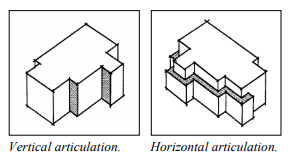
(2) “Blank walls” means walls without windows, plantings, or architectural elements, such as modulation.
(3) “Building mass” means height, width, and depth of a building structure.
(4) “Cornice” means the horizontal projection, molded or otherwise decorated, that crowns the top of a building.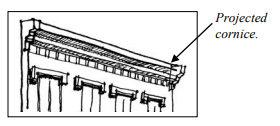
(5) “Facade” means the exterior wall of a building exposed to public view or that wall viewed by persons not within the building.
(6) “Massing” means how the three-dimensional building forms are grouped to create the general shape and form of the building.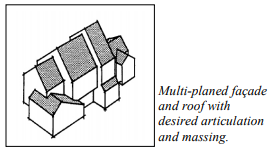
(7) “Modulation” means variation in the building mass through the use of stepbacks, setbacks, diminishing upper floor areas, and/or projecting roof overhangs.
(8) “Outdoor display area” means areas outside the building structure where merchandise is displayed for customers.
(9) “Outdoor storage area” means outdoor areas where merchandise is kept for temporary storage purposes but not for display; or the keeping in an unroofed area of any goods, junk, material, merchandise, supplies, or vehicles in the same place for more than twenty-four hours.
(10) “Parapet” means the vertical extension of the main walls of a building above the roofline.
(11) “Pedestrian-oriented commercial use” means a commercial enterprise whose customers may likely arrive by foot, which may include restaurants, retail shops, personal service businesses, financial institutions (except drive-thru windows), and other similar establishments that generally benefit from pedestrian activity.
(12) “Proportion” means the ratio of building elements, including height, mass, and depth. Good proportion is a harmonious arrangement or relation of parts or elements within a whole.
(13) “Roofline” means the outer edge of the roof that provides visual terminus to the top of the building.
(14) “Roofline variation” means the roofline articulated through a variation or step in roof height or detail, such as pitched roof, projecting cornice, articulated parapet, or terraced roof.
|
|
|
(15) “Scale” means the relationships of a development and/or its elements in terms of size, height, bulk, intensity, and aesthetics to one another and to the surroundings. “Human scale” would identify the relationship of the building to human beings.
(f) Massing and Architectural Features.
(1) Intent. To reduce the bulk of the buildings by breaking down the mass into human scale, in order to offer variety and consistency along the street face.
(2) Mandatory Standards.
(A) Buildings of two or more stories or with a total height of twenty feet or more must display the proportion of a “base,” “middle,” and “top” in massing. “Top” can be expressed by using sloped, gabled, or flat roofs. Flat roofs shall have cornices, parapets, or similar special features to act as the top of the building. Stepbacks of the buildings at the upper floors can also be used as a method to express base, middle, and top.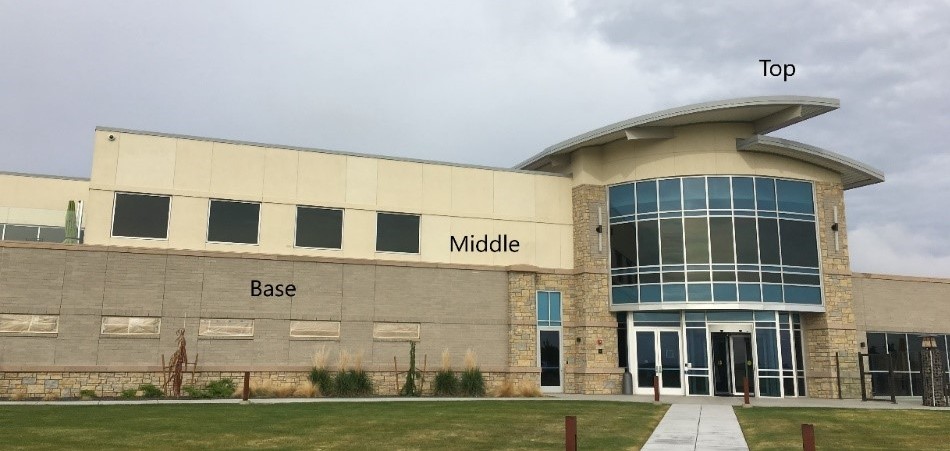
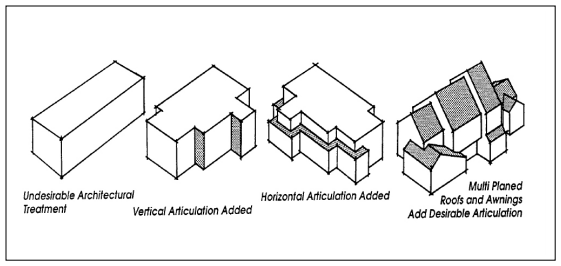
(B) A street-facing facade more than fifty feet long shall include the following treatments:
(i) Change in the roof or wall plane (four-foot minimum);
(ii) Projecting or recessed elements;
(iii) Varying rooflines at four-foot minimum.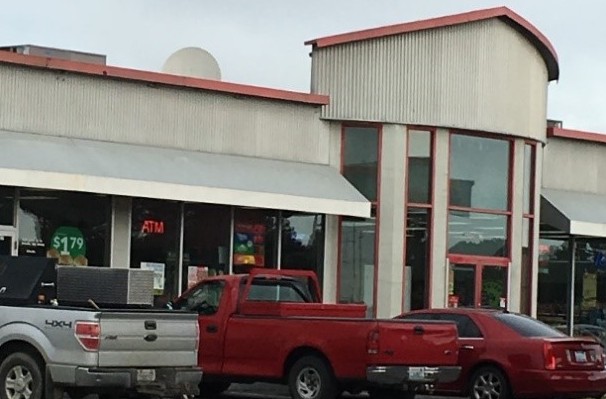
(C) Solid blank facades must be avoided on the front and all street-facing sides of the building. These facades must be treated with windows, entrances, canopies, cornices, and by articulating the facade and/or screening with landscaping.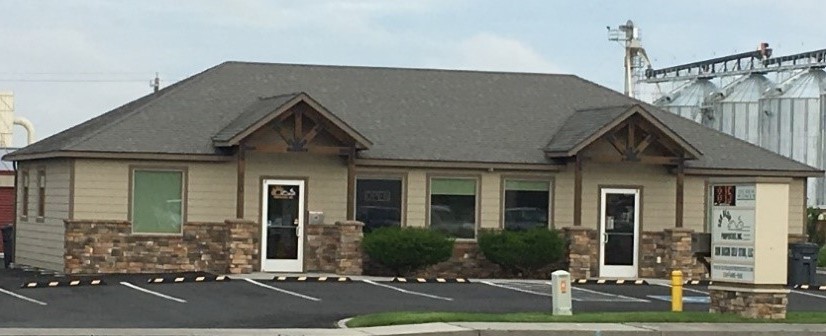
(D) For slope roof structures, the slope of the roof must not be less than 4:12 except when a specific design is approved by the community development director.
(3) Recommended Standards.
(A) Building height should be compatible with the surrounding building heights and character of the area.
(B) Buildings should use elements such as canopies, awnings, trellises, pergolas, and arcades to provide human scale.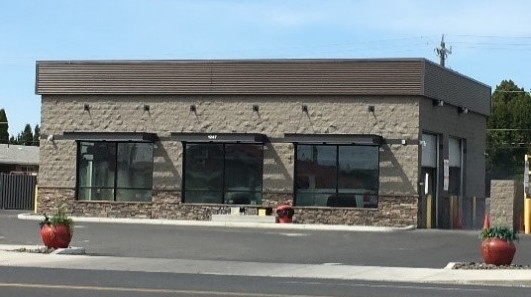
(C) Solid blank facades when unavoidable should be treated with modulation, canopies, wall-mounted lighting, artwork, and landscaping trellises.
(g) Prominent Entrance.
(1) Intent. To ensure visible, attractive, inviting, and efficient entrances to buildings.
(2) Mandatory Standards.
(A) Entrance to the building must be made visible and prominent by using large entry doors, porches, protruding, or recessed entrances.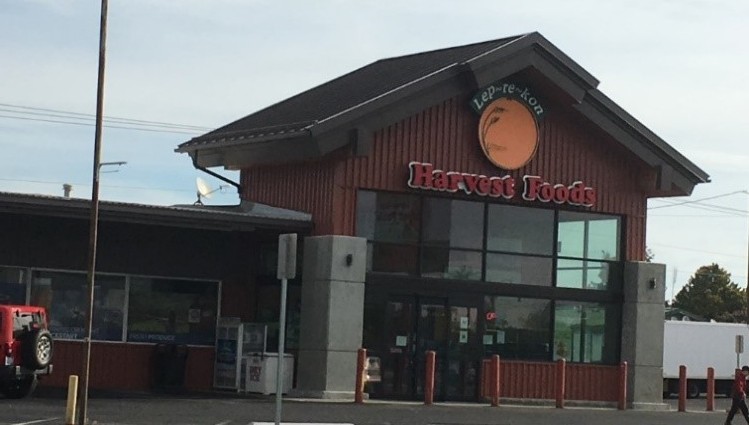
(B) Primary pedestrian entrances must face public streets, open spaces, or plazas whenever available.
(C) Light poles, signage, and similar accessories shall be coordinated so that the view and accessibility to the entrance are not obstructed.
(3) Recommended Standards.
(A) Special paving is encouraged at the entrance to the building.
(B) Special architectural treatment that signifies the entrance without destroying the architectural character is encouraged. Examples include using different materials such as brick, stone, or glass at the entrance, or locating the entrance at the junction of two building masses.
(C) For multi-story buildings, the building entrance should be scaled down to relate to human scale.
(h) Facade Transparency.
(1) Intent. To create a visual connection between the indoor and outdoor environment in order to make businesses more attractive.
(2) Mandatory Standards.
(A) Solid blank walls shall be avoided except for service areas where it shall be screened from public view (see subsection (j) of this section, Service Areas and Backs of Buildings).
(B) Facades facing public streets or public open spaces must be treated with a combination of prominent primary or secondary entrance, display windows, transparent facades, facade modulation, canopies, and/or awnings.
(C) For retail buildings: Facades facing public streets or public open spaces or plazas shall have at least forty percent of the facade area comprised of transparent glass at the ground level unless a specific alternative design is approved by the community development director.
(D) For office buildings: Facades facing public streets or public open spaces or plazas hall have at least twenty-five percent of the facade area comprised of transparent glass unless a specific alternative design is approved by the community development director.
(E) Transparent glass for facade transparency at ground level means between two feet and twelve feet from the ground level.
(F) Display windows along public streets shall express the type of business by displaying products sold or other displays that relate to the business. Signage on windows shall not be considered as part of the display window.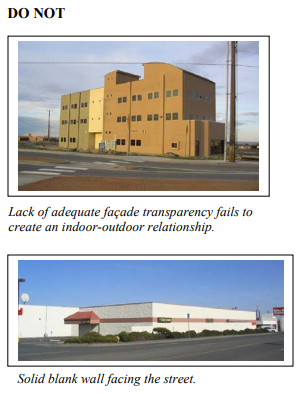
(3) Recommended Standards.
(A) Tinted or reflecting glass is discouraged at the ground level where it prevents visual connection between indoor and outdoor environments.
(i) Treatment of the Corner.
(1) Intent. To ensure that businesses at street intersections can serve as landmarks and be integrated with the pedestrian realm.
(2) Mandatory Standards.
(A) Buildings located at the corner of street intersections shall have at least one of the following:
(i) A primary pedestrian entrance complying with the “prominent entrance” standard (see subsection (g) of this section) and accessible from the corner street sidewalks.
(ii) Distinctive massing and roof form of the building to mark the intersection as a landmark.
(iii) Other architectural features such as porches, canopies, and display windows at the corner.
(B) Signage and accessory structures must not obstruct the view of the building at the corner.
(C) Corner treatments shall not obstruct safe sight distance at corners.
(3) Recommended Standards. The corner of the building should be coordinated with the overall site design.
(j) Service Areas and Backs of Buildings.
(1) Intent. To reduce the negative impacts of the backs of buildings and of service areas.
(2) Mandatory Standards.
(A) Loading and service areas shall be located in less visible areas of the site.
(B) Service areas and backs of buildings shall not be located facing a public street. Alleys should be used for access to service areas where available. In cases where there are no other options, the street and site layout, service areas, and building back facing public streets must be screened from public view with solid screen landscaping, grading, and/or fencing.
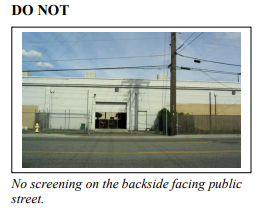
(C) The back of a building shall be consistent with the front of the building, in terms of design style, building materials, and architectural features.
(3) Recommended Standards. Solid blank facades should be treated with some combination of facade modulation, canopies, lighting, artwork, and landscaping trellises.
(k) Screening of Electrical and Mechanical Equipment.
(1) Intent. To minimize negative visual impacts of service equipment on the business and the adjacent area.
(2) Mandatory Standards.
(A) Electrical and mechanical equipment when placed on the rooftop shall be obscured from view, such as by using parapets.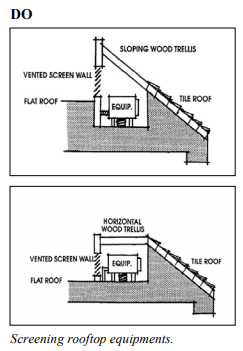
(B) Electrical and mechanical equipment when placed on the ground shall comply with the service areas standards (subsection (j) of this section).
(3) Recommended Standards.
(A) Increased parapet height can be accepted when used for screening the equipment from view.
(B) Screening of equipment should be consistent with the overall building design style, building materials, and architectural features.
(l) Material.
(1) Intent. To enhance the character of the building and the area in order to make the business more attractive to customers, areas residents, and visitors.
(2) Mandatory Standards.
(A) Exterior building materials should be selected for suitability and high degree of performance. The building facade should be a combination of materials to add variation to the facade design. Preferred materials include masonry, stone, stucco, wood, or similar materials.
(B) A combination of materials should be used to add variation to the design.
|
|
|
(3) Recommended Standards.
(A) Color. Neutral and earth tones are preferred. Buildings should fit into the area. (Ord. 1547 § 4 (part), 2020).
17.30.080 Design standards in the C-3 zone.
For buildings over twelve thousand square feet in the C-3 zone, the following standards apply:
(a) Entrance.
(1) Intent. To ensure that building entrances are clearly visible and identifiable to pedestrians.
(2) Standards.
(A) The principal entry to the building should be made prominent with canopies, overhangs, protruding or recessed masses.
(B) The building entrance should offer some degree of weather protection and act as a transition between indoor and outdoor environments.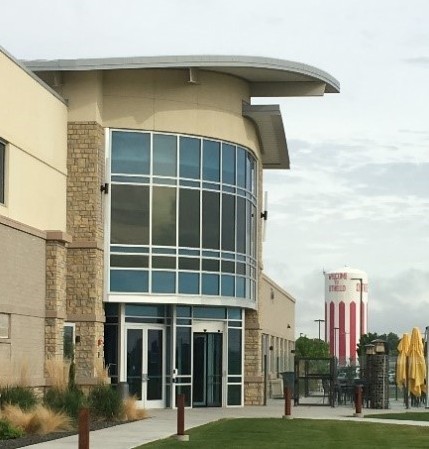
(b) Massing.
(1) Intent. To reduce the impact of the large bulk of the building.
(2) Standards. For street-facing facades more than one hundred feet long, break down the building mass with the following:
(A) Change in the roof or wall plane (four feet minimum every one hundred feet). This does not need to be at regular intervals if approved by the community development director as a design feature.
(B) Use projecting or recessed elements in the facade.
(C) Vary the building rooflines.
(c) Facade Treatment.
(1) Intent. To break the monotony of continuous building facades.
(2) Standards.
(A) Modulate and articulate the facade.
(B) Treat the solid wall with landscaping, trellises, canopies, inserted lighting, modulation, and articulation.
(C) Provide more window/visibility/indoor-outdoor relationships.
(D) Select color and material to add variety.
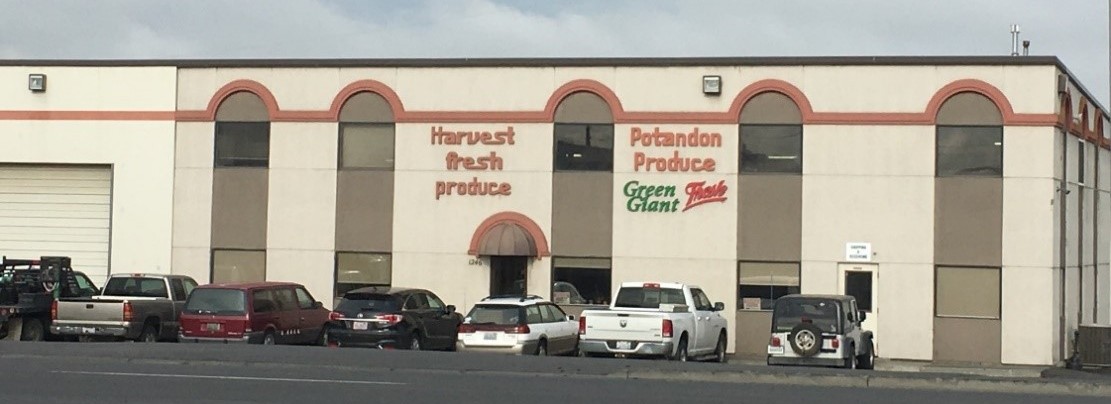
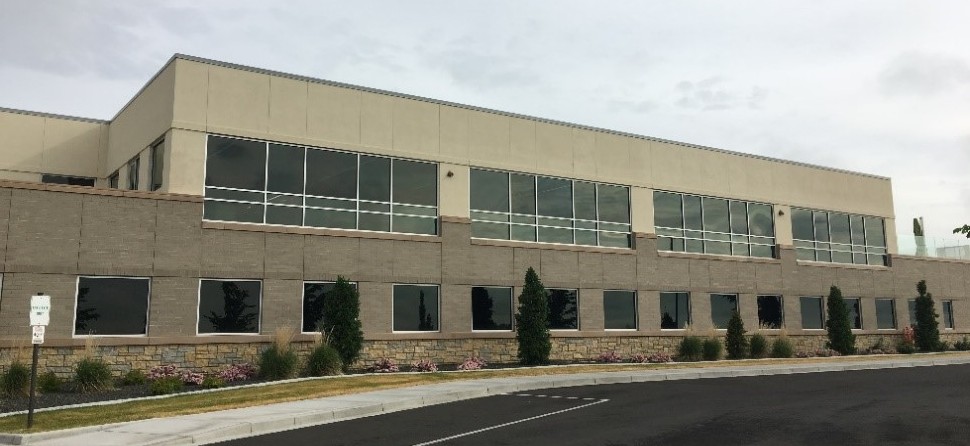
(d) Outdoor Storage and Display Areas.
(1) Intent. To reduce the negative impact of service areas.
(2) Standards.
(A) All nonenclosed storage areas must be located at the rear, or non-street side, of the building.
(B) If such areas need to be covered, the covering shall be consistent with the overall building design. (Ord. 1547 § 4 (part), 2020).
17.30.090 Construction code requirements.
All uses in the commercial zones must be in compliance with the applicable requirements of the building code, the fire code, the mechanical code, and the plumbing code except as may be provided in this chapter. All uses must be associated with a principal use which must be in an enclosed adjoining building. (Ord. 1547 § 4 (part), 2020).
17.30.100 Fences and walls.
Fences and walls not exceeding eight feet in height may be permitted subject to the requirements of this section. Prior to construction or installation, all fences and walls will require a fence permit and/or a building permit issued by the building and planning department. Electric and barbed wire fences are prohibited, except that security fences containing barbed wire may be permitted subject to review by the building official regarding the safety of such a fence. All applications for permits to construct or install fences or walls shall be reviewed by the building official and city engineer for vehicular and pedestrian safety. A fence enclosing property may be required to have a gate with an approved lock box or lock installed for emergency vehicle access. (Ord. 1596 § 2, 2023; Ord. 1547 § 4 (part), 2020).
17.30.110 Stormwater and drainage.
(a) Each use shall provide for approved on-site or off-site detention or control of excess stormwater runoff or drainage resulting from the use. No use shall cause downstream property owners to receive stormwater runoff at a higher peak flow than would have resulted from the same event had the use or improvement not been present.
(b) Stormwater runoff or drainage shall be controlled and contained on site except where adequate off-site storm drainage systems are available. Stormwater runoff and/or drainage resulting from a use must be controlled so that water will not flow onto a public sidewalk or onto adjacent property. Drainage into city storm sewer or onto a city street must be approved by the public works director. (Ord. 1547 § 4 (part), 2020).
17.30.120 Pedestrian standards.
(a) Purpose. The pedestrian standards encourage a safe, attractive, and usable pedestrian circulation system. They ensure a direct pedestrian connection between the street and buildings on the site.
(b) Applicability. The standards of this section apply to all development in the C-2 and C-3 zones with parking lots containing more than one hundred parking spaces.
(c) Required Connections.
(1) Between the public right-of-way and building entrances.
(2) Between parking lots and building entrances.
(d) Width. Pedestrian connections shall be no less than five feet wide.
(e) Materials. Striping may be used to delineate walkways from the nearest edge of the parking lot to the building entrance. All other pedestrian connections shall be clearly defined by at least two of the following:
(1) Six-inch vertical curb.
(2) Textured paving, including across vehicular lanes.
(3) A continuous landscape area at a minimum of three feet wide on at least one side of the walkway. This landscaping can be counted toward the required parking lot landscaping.
(4) Trellis.
(5) Special railing.
(6) Bollards.
(7) Special paving.
(8) Low seat wall and/or other architectural features.
(f) Lighting. The on-site pedestrian circulation system shall be lighted to an intensity where the system can be used at night by employees, residents, and customers. Lighting should be at a height appropriate for a pedestrian pathway system. (Ord. 1547 § 4 (part), 2020).



